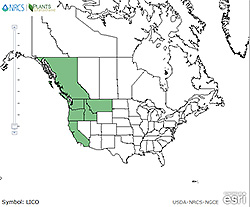Plant of the Week
 Lilium columbianum range map. USDA PLANTS Database.
Lilium columbianum range map. USDA PLANTS Database.
 Columbian Lily (Lilium columbianum). Photo by Charmaine Delmatier.
Columbian Lily (Lilium columbianum). Photo by Charmaine Delmatier.
 Columbian Lily (Lilium columbianum) habitat. Photo by Charmaine Delmatier.
Columbian Lily (Lilium columbianum) habitat. Photo by Charmaine Delmatier.
Columbian Lily (Lilium columbianum)
By Charmaine Delmatier (2018)
A member of Liliaceae (commonly known as the lily family), Columbian lily (Lilium columbianum) occurs in western North America stretching from British Columbia in the north to California in the south, and then east to Montana, Idaho, and Washington. It is a widespread native perennial with one strong unbranched stem reaching as high as four feet. Originating from a large white ovoid bulb, several large pendant to nodding flowers range in color from yellow to orange to reddish, and are loosely arranged in a bracteate raceme. The flowers resemble a turk’s cap with sepals and petals reflexed, reaching a length of 6cm. Each flower is then speckled with a profusion of reddish to maroon spots. Also noticeable are six exerted stamens, the filaments easily seen in many populations contrasted with dark brown anthers. All these uniquely aesthetically-contrasting features make for a striking display.
Its habitat is broad ranging from coastal scrub to prairies, meadows, coniferous forests, clearings, and roadsides. Columbian lily can be found at lower drier elevations and as high as 9,800 feet. Also known as tiger lily, it has a long flowering period, from early May to early August.
Worldwide, members of the lily family are primarily found in tropical regions, so it is a special treat to find these often-colorful tubular flowers in micro-mountainous areas. Across the globe, there are approximately 280 genera and 4,200 species. Specifically, to North America, there is still a robust representation of 70 genera and 478 species. Occurring worldwide, they include trees, shrubs, vines, and herbs. With the genus Lilium, there are 100 separate lily species worldwide, with 22 represented in North America. They are usually found in temperate Northern Hemisphere and south to the mountains of Asian tropics.
Within his treatment of Lilium in Flora of North America, Mark W. Skinner, explains that even though true lilies are distributed worldwide, the highest center of diversity occurs in Eastern Asia and North America. Approximately 52 million years ago, the lily family evolved between the late Cretaceous and early Paleocene eras. Diverse and globally significant, the lily family is a mainstay as nursery ornamentals, including lilies (Lilium), tulips (Tulipa), fritillaries (Fritillaria), and Erythronium. The white Madonna lily (Lilium candidum), native to the Balkan peninsula and Middle East, has been cultivated for over 300 years and is significant in religious ceremonies worldwide. In 2017, the Netherland tulip industry produced over two billion bulbs which generated 10% of their gross domestic product (GDP).
It has been reported, that when dried, day lilies are an effective diuretic or laxative. Flowers and roots of several lilies have been used to treat spider bites and their roots are used as medicinal teas utilized to treat stomach disorders, coughs, tuberculosis, and fevers. As a food source, the corms (swollen underground plant stems) are edible. Corms are a critical component of its life cycle; and serve as a storage organ to over winter or withstand summer drought.
Columbian lily bulbs are used a food source and as a peppery condiment. The oval-shaped bulb can reach up to 5cm in diameter, is starchy, and eaten like a potato. Known for its slightly sweet flavor, it is said to resemble sweet chestnuts. For native people, it became a staple food source.
The first mention of a lily dates back about 4,000 years. Ancient Egyptians revered the lily and entombed it with their dead. Artifacts depicting the white Madonna lily have been unearthed in ancient cities in Crete, Greece and Mesopotamia. Finding a lily in the wild is like walking back through time thousands of years. By many, it is observed as the symbol of life, and no other flower is associated with the observance of Easter more than the lily.

